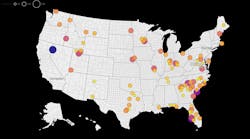Latest from Market Sales Estimates
AIA’s Mid-Year Consensus Construction Forecast Sees a Soft Market Through 2021
As a result of the partially shutdown economy, businesses and organizations will continue to be hesitant to invest in modernized or new facilities, according to a mid-year update to the American Institute of Architects’ (AIA) Consensus Construction Forecast. AIA said the trend ends an almost decade-long expansion in construction spending.
The AIA Consensus Construction Forecast Panel — consisting of construction economists from Dodge Data & Analytics, IHS Economics, Moody’s Analytics, FMI, ConstructConnect, Associated Builders & Contractors, Wells Fargo Securities and Markstein Advisors — projects spending on nonresidential facilities will decline just over -8% this year and another -5% in 2021. The commercial building sector is expected to be the hardest hit, with spending projected to decline almost -12% this year and another -8% in 2021. The industrial sector is slated to see declines of -5% this year and -3% next year. While institutional buildings will fare the best on the nonresidential side, spending on these facilities is projected to drop almost -5% this year, and another -2% next year.
“As much of the economy was shut down in mid-March to help limit the spread of the pandemic, there was hope that after the initial steep decline in economic activity there could be an almost equally quick recovery,” said AIA Chief Economist Kermit Baker, in the press release. “However, since mid-June economic growth has stalled. The timing coincides with a spike in new COVID-19 cases across the country, and the resulting pause or roll-back of reopening plans in many states.”
AIA offers further details on its mid-year update to the Consensus Construction Forecast at www.aia.org. The post there offered some reason to expect a surge in facility retrofits. “Once the economy reopens, there will be a dramatic need for post-pandemic design in most existing buildings. This will drive a surge in building retrofits, which will benefit the design and construction industries.
“However, there are also a set of downside risks that could further delay a stronger economic recovery — a much longer time line to bring the pandemic under control; the need for new business models; growing evictions/defaults/bankruptcies feeding into a more traditional demand-driven recession; and growing trade tensions.”
AIA’s Consensus Construction Forecast had a rather stern long-term outlook for office construction over the next few years and said the “dramatic downturn” in office employment and popularity of telecommunicating may tamp down demand for more office space. The forecast also saw big declines in demand for hotels in the near future and limits to the amount of new educational construction.
“At almost $100 billion in spending last year, education is the largest nonresidential building category,” said the post at www.aia.org. “Spending on education facilities saw a modest gain last year, but is projected to decline almost -7% this year, and another -1% next. With many schools and colleges relying heavily on virtual teaching for the remainder of 2020, there is less need for additional facilities, and fewer resources to support them. Additionally, the demographics supporting growth in educational facilities are mixed, with slower growth for college age students leading to a modest net decline in college enrollments in recent years.”









